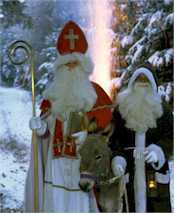
The wide variety of Christmas customs throughout Swiss villages reflects centuries of winter isolation that townsfolk endured when the heavy snow eliminated travel between mountain valleys.
In the canton or province of Vaud where St. Maurice is located, a Christmas lady named Tante Arie is a bearer of gifts. She is represented as an old woman, half fairy, half witch, who comes down from a mountain on Christmas Eve, riding a donkey. She brings gifts for good children but birch rods or dunce caps for the naughty ones.
Usually on December 6, the feast of St. Nicholas, Swiss school children parade through their villages, ringing bells of all sizes. The bells alert the villagers that a gift is expected from each household along the way. The gifts are usually some good things to eat or drink.
The children's parade in the town of Weinfelden happens the last Thursday before Christmas. The children in the town parade through the streets with decorated beets. These beets have been hollowed out and lit from within with a candle. After singing carols in the town square, the children go to their schools where they dine on sausage and bread. At the same time, adults go the local tavern or coffeehouse, and the town council holds its annual budget meeting!
In the village of Ziefen, several dozen young bachelors walk a traditional route through the streets every Christmas Eve. The tallest bachelor dons a white beard and leads the procession while carrying a sooty rag attached to the end of a long pole. All the young bachelors wear oversized, long, dark coats and each wears a tall, black, top hat made of cardboard. Many of these hats are more then six feet high. Quiet a few onlookers get a face full of soot.
Celebrations are relatively quiet in the village of Hallwil where seven girls, 13 or 14-years-old, act out an ancient custom. A veiled Weihnachtchild (Christmas child), dressed in white, and six companions in rose-colored gowns visit village families in the evening. The Weihnachtchild greets the families with a silent handshake and distributes cake or cookies to the children while the other girls sing a carol. The departure of this group is also silent.
There is a crazy, yet ancient New Years Eve tradition in the town of Laupen. After dark on December 31, participating schoolboys, in three boisterous groups, meet on the hill at the local castle and proceed down to the village. In the first group are the "bell ringers", who swing large bells heard for miles around.
Next, the "broom men", carry long poles with bunches of juniper branches tied to the top. The third, and most bizarre group, the "bladder men" carry pig's bladders filled with air. The procession stops at various locations along the route as the leader recites a poem to the old year and wishes the crowd a happy new one. During the poem, the broom men wave their juniper brooms over the heads of the crowd. At the end of journey, the broom men and the bladder men, all armed with inflated pig's bladders, proceed to "beat" the onlookers, especially young ladies, until their weapons are in shreds.

